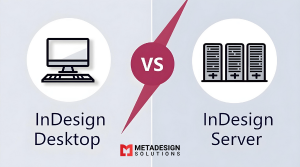Adobe InDesign is a powerful tool for designers, publishers, and marketers who need high-quality layouts for digital and print media. However, many users require additional functionalities beyond InDesign’s built-in features. This is where InDesign plugin development comes in.
By using Adobe ExtendScript and JavaScript API, developers can create plugins that automate repetitive tasks, enhance user experience, and improve workflow efficiency. This guide provides a detailed, hands-on approach to creating an Adobe InDesign plugin, covering setup, coding examples, and best practices.
Why Develop an Adobe InDesign Plugin?
Businesses and designers often require specialized tools to streamline their workflows. Here’s why custom InDesign plugins are beneficial:
✅ Automation: Reduce manual effort in typesetting, layout adjustments, and formatting.
✅ Enhanced Features: Add new functionalities that are not available by default.
✅ Integration: Connect InDesign with third-party tools like CMS, DAMs, and CRMs.
✅ Time-Saving: Speed up tasks that usually take hours to complete manually.
Many companies hire Adobe InDesign plugin developers to build plugins tailored to their specific needs, improving efficiency and productivity.
Setting Up the Development Environment
Before writing code, you need to set up your Adobe InDesign ExtendScript development environment.
1. Install Adobe InDesign
Ensure you have Adobe InDesign CC installed on your computer.
2. Use Adobe ExtendScript Toolkit (ESTK)
Adobe ExtendScript is based on JavaScript and is used to create InDesign scripts and plugins. Download ExtendScript Toolkit (ESTK), which helps in writing, testing, and debugging scripts.
📌 Note: Adobe has discontinued ESTK in newer versions. Use VS Code with Adobe ExtendScript Debugger for modern development.
3. Locate the Scripts Panel in InDesign
- Open InDesign
- Go to Window → Utilities → Scripts
- Right-click on User → Reveal in Finder/Explorer
- This opens the Scripts Panel folder where you can save and run scripts
4. Create a New JavaScript File
- Open Notepad++ or VS Code
- Save the file as MyFirstPlugin.jsx in the Scripts folder
Understanding Adobe InDesign Scripting API
Adobe provides an extensive JavaScript API for InDesign that allows:
✔ Document Automation – Modify and create layouts programmatically
✔ Text and Object Manipulation – Format text, images, and page elements
✔ User Interaction – Add UI elements like dialogs, alerts, and panels
✔ File Exporting – Automate PDF, EPUB, and XML exports
Basic Script Structure
Every InDesign plugin interacts with the active document. Below is a simple ExtendScript example:
javascript code:
var doc = app.activeDocument; // Get the current document
var page = doc.pages[0]; // Select the first page
var textFrame = page.textFrames.add(); // Create a text frame
textFrame.geometricBounds = [50, 50, 200, 400]; // Position the text frame
textFrame.contents = "Hello, InDesign!"; // Add text
alert("Text frame created successfully!");
Automate InDesign with Custom JavaScript Plugins
Need custom tools for layout or publishing? Connect with MDS to build ExtendScript-based InDesign plugins tailored to your workflow.
💡 This script creates a text box on the first page and inserts “Hello, InDesign!”.
Building a Simple InDesign Plugin
Step 1: Creating a UI for the Plugin
To make a plugin interactive, you can create a dialog box using Window object.
javascript code:
var myDialog = new Window("dialog", "My InDesign Plugin");
myDialog.orientation = "column";
var text = myDialog.add("statictext", undefined, "Click OK to create a text frame");
var okButton = myDialog.add("button", undefined, "OK", { name: "ok" });
okButton.onClick = function() {
createTextFrame();
myDialog.close();
};
myDialog.show();
Step 2: Adding Functionality to the Plugin
Now, define the createTextFrame function:
javascript code:
function createTextFrame() {
var doc = app.activeDocument;
var page = doc.pages[0];
var textFrame = page.textFrames.add();
textFrame.geometricBounds = [50, 50, 200, 400];
textFrame.contents = "This is a custom plugin text frame.";
alert("Text frame added!");
}
Step 3: Running the Plugin
- Save the script as MyFirstPlugin.jsx in the Scripts Panel folder.
- Open InDesign, go to Scripts Panel, and double-click the script.
- A dialog box will appear; click “OK,” and the text frame will be created.
🚀 Congratulations! You’ve just built your first Adobe InDesign plugin!
Advanced Features for InDesign Plugin Development
1. Working with Images
You can create a plugin that inserts images into InDesign documents:
javascript code:
var file = File.openDialog("Select an image");
if (file) {
var doc = app.activeDocument;
var page = doc.pages[0];
var imageFrame = page.rectangles.add();
imageFrame.geometricBounds = [50, 50, 300, 500];
imageFrame.place(file);
alert("Image inserted successfully!");
}
2. Exporting Documents as PDFs
Automate the process of exporting files to PDF:
javascript code:
var myDocument = app.activeDocument;
var myFile = File("~/Desktop/ExportedPDF.pdf");
var myPDFExportPreset = app.pdfExportPresets.item("[High Quality Print]");
myDocument.exportFile(ExportFormat.pdfType, myFile, false, myPDFExportPreset);
alert("PDF exported successfully!");
3. Generating Tables Automatically
This script creates a simple table in InDesign:
javascript code:
var doc = app.activeDocument;
var page = doc.pages[0];
var tableFrame = page.textFrames.add();
tableFrame.geometricBounds = [50, 50, 300, 500];
var myTable = tableFrame.insertionPoints[0].tables.add();
myTable.columnCount = 3;
myTable.rowCount = 5;
alert("Table created successfully!");
Debugging and Testing Your Plugin
Debugging is essential to ensure smooth performance.
✅ Use $.writeln() for logging output:
javascript code:
$.writeln("Debug message: Script is running");
✅ Check for active documents:
javascript code:
if (app.documents.length === 0) {
alert("No active document found.");
}
✅ Use Try-Catch Blocks for Error Handling:
javascript code:
try {
createTextFrame();
} catch (e) {
alert("An error occurred: " + e.message);
}
Deploying and Distributing Your InDesign Plugin
Once your plugin is complete, you may want to share or sell it.
1. Packaging the Plugin
- Save the .jsx script in the Scripts Panel folder.
- Convert it to a .jsxbin file for security using Adobe ExtendScript Toolkit.
2. Selling Your Plugin
- Publish it on Adobe Exchange or third-party marketplaces.
- Offer it as a SaaS tool for businesses and designers.
3. Hiring an InDesign Plugin Developer
For businesses looking for custom InDesign plugin development, hiring experts ensures better performance, security, and scalability. Hire InDesign Plugin Developers today for automation and advanced features.
Conclusion
Developing an Adobe InDesign plugin using ExtendScript and JavaScript API is a great way to enhance workflows, automate tasks, and add new features. Whether you are an individual designer or a business, building custom plugins can save time and improve efficiency.
If you need a custom plugin for your InDesign projects, you can hire InDesign plugin developers to create tailored solutions that meet your exact needs.
Related Keyphrase:
#InDesignPluginDevelopment #AdobeInDesign #ExtendScript #InDesignAutomation #JavaScriptAPI #AdobeScripting #HirePluginDevelopers #GraphicDesign



